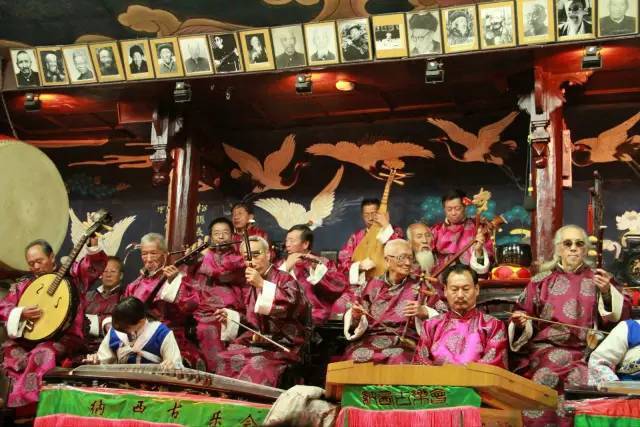Chinese Name: 纳西古乐 Pronunciation: nàxī gǔyuè
Type: Music concert show
Show Length: About 1 and a half hour
Recommended Time for Visit: 1-3 Hours
Occupied Area: The hall can accommodate about 400 people
Address: Naxi Concert Hall, No. 86, Mishi Lane, Xinhua Street, Old Town Zone, Lijiang, Yunnan Province, China
Opening Hours: Every day from 20:00 to 21:30 (Note: The concert will be canceled if there are less than six viewers.)
| Tourists | Price |
| Adults | CNY 160 for A-zone tickets CNY 140 for B-zone tickets CNY 120 for C-zone tickets |
| Children | 50% discount for children from 1.2 meters to 1.4 meters; Free for children below 1.2 meters |

Naxi Ancient Music originated in the 14th century, is the most time-honored folk music of Yunnan Province in southwestern China. Even more, it is one of the most ancient music of China, or, around the world.
Naxi Ancient Music is hailed as a “living fossil of Chinese music” for its quite long styles and history. Evidenced by archaeologists, Naxi Ancient Music is shaped by Baisha Xiyue, Dongjing music, and Huangjing music. Besides, the music has been influenced by Cipai (names of the tunes to which ci poems are composed) of the Tang, Song and Yuan Dynasties (618 - 1368), Qupai (named tune to which qu is composed) music, Taoist Ritual Music, and Yayue (Confucian ceremonial music).
Baisha Xiyue: It is supposed to be brought to Lijiang by Kublai Khan in 1253, which has been passed down for centuries. It is a dance and song show but the main part is the instrumental ensemble. Eight movements are included in Baisha Xiyue. Each movement is closely linked in tone and has a strict structure, which can be played individually or in a large suite, expressing the sense of desolation, grief, and nostalgia.
Dongjing music: It was popular Taoist ritual music in the Central Plain of China during the Ming and Qing Dynasties (1368-1912), and was introduced into and well-preserved in Lijiang. Xuan Ke, the president of Dayan Naxi Ancient Music Association said that the origin of Dongjing music came from the imperial and religious music of the Tang and Song Dynasties.
Huangjing music: It has been no longer known.
The entire Ancient Music is divided into two major keys, named “Shenzhou” and “Huatong”, and has over 50 minor keys based on different content. More than 20 minor keys are frequently taken on the stage, including “Waves Washing the Sands (浪淘沙)”, “Song of the Water Dragon (水龙吟)” and “The Sheep on the Hill (山坡羊)”, etc. The set of music has been widely played in the region for a long time, gradually integrating the aesthetic of the Naxi people and unique music instruments. It, therefore, was called “Naxi Ancient Music”.
Naxi Ancient Music is characterized as “Three Old Treasures”: old music, old instruments, and old musicians.
It’s no doubt that Naxi Ancient Music has been witnessed its absorption, integration, and development with other types of music for centuries. That’s the first treasure.
In the concert, the needed instruments, held by the musicians are hundreds of years old, such as Yunlong with ten small tuned gongs in a frame (十面云锣) and bent-neck pipa (曲颈琵琶). That’s the second treasure.
The last treasure is the experienced musicians. Most of them are over 70 years old. The music must be passed down from master to apprentice or from father to son, through oral teaching or reciting the Gongchi notation (a traditional musical notation method). Therefore, only a few and elder artists can play the music and use the ancient instruments. That’s the third treasure.
After centuries of development and changes, Naxi Ancient Music has formed a unique style.
In 1987, the Dayan Naxi Ancient Music Association was formed by Dongjing music master Xuan Ke, He Yi’an, and Yang Zenglie to revive the Ancient Music.
In 1995, Naxi Ancient Music also went abroad and was invited to the United Kingdom for a visit. In the same year, it was invited to Norway by the King of Norway to participate in the Bergen International Festival, attracting globally widespread attention.
In 2000, three bylaws concerning Dongjing protection, including the “Protection by Law for National Folk Traditional Culture in Yunnan Province” were passed.
In 2011, Baisha Xiyue was listed as a National Intangible Cultural Heritage.
In recent years, Naxi Ancient Music performance has become an attraction of Lijiang, which is loved and enjoyed by tourists.
While you are visiting in the Old Town of Lijiang, it is in walking distance to the Dayan Naxi Concert Hall. You can also take a taxi to the concert hall in Lijiang.
By Taxi
Chinese: 请带我去大研纳西古乐会。English: Please take me to the Dayan Naxi Concert Hall.
